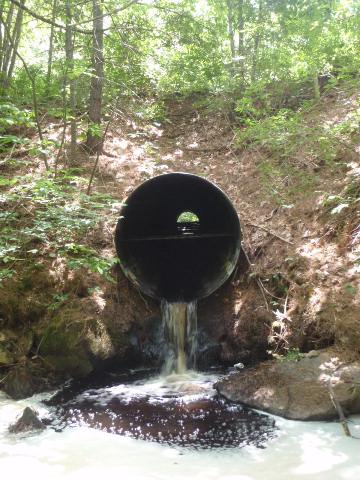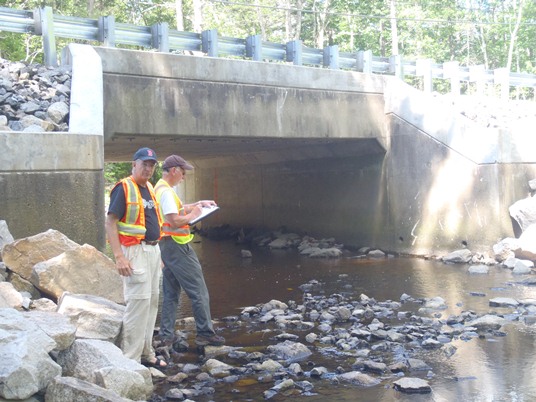The Wrack
The Wrack is the Wells Reserve blog, our collective logbook on the web.
The Wrack is the Wells Reserve blog, our collective logbook on the web.
Back in July, Wells Reserve staff and interns teamed up with volunteers from the Sebago Chapter of Trout Unlimited and bravely struck out on an ambitious survey of road-stream crossings in the Kennebunk River, Merriland River, and Branch Brook. The teams worked hard and surveyed an amazing 81 road-stream crossings in only three days!
 I led one of the survey teams and let me tell you, that data was hard-earned! Once we had located a crossing, we had to battle thick brush, mud, poison ivy and steep slopes of riprap to reach the stream. To measure the length of a crossing, we sometimes had to crawl through a culvert from one end to the other, dodging spider webs along the way. Besides being a fun excuse to go crashing through woods and splashing through rivers, this survey was an important way to gather data that will be used by town planners, landowners, conservation groups, and other stakeholders to reconnect stream habitat in these watersheds.
I led one of the survey teams and let me tell you, that data was hard-earned! Once we had located a crossing, we had to battle thick brush, mud, poison ivy and steep slopes of riprap to reach the stream. To measure the length of a crossing, we sometimes had to crawl through a culvert from one end to the other, dodging spider webs along the way. Besides being a fun excuse to go crashing through woods and splashing through rivers, this survey was an important way to gather data that will be used by town planners, landowners, conservation groups, and other stakeholders to reconnect stream habitat in these watersheds.
Culverts and other types of road-stream crossings were historically designed with little consideration for fish and other animals that need to pass through. In fact, many of these crossings completely block the passage of fish, cutting off miles of river habitat. Access up- and downstream is vital to fish and other water-dwelling animals for finding food, shelter, mates, nesting areas, and other resources. Even land animals are affected by road-stream crossings since they use streams as corridors for moving through the forest.
 The importance of making fish- and wildlife-friendly road-stream crossings was recognized by the Maine legislature when they passed a bill that called on the Department of Environmental Protection (DEP) to amend their Permit By Rule standards. New culverts would be required to achieve “natural stream flow” enabling the passage of fish and other aquatic organisms. The bill was met with concerns about financial viability and the DEP has yet to implement the design suggestions into its rule book. Still, some town officials are looking ahead and beginning to construct more fish- and wildlife-friendly road-stream crossings.
The importance of making fish- and wildlife-friendly road-stream crossings was recognized by the Maine legislature when they passed a bill that called on the Department of Environmental Protection (DEP) to amend their Permit By Rule standards. New culverts would be required to achieve “natural stream flow” enabling the passage of fish and other aquatic organisms. The bill was met with concerns about financial viability and the DEP has yet to implement the design suggestions into its rule book. Still, some town officials are looking ahead and beginning to construct more fish- and wildlife-friendly road-stream crossings.
Unfortunately, towns have a big job ahead of them. Very few of the culverts we surveyed met the design standards and some were creating severe barriers to fish and wildlife movement. The worst culverts were perched high above the stream, requiring fish to leap several feet in the air in order to continue upstream. Other culverts channeled a large flow of water through a small tube, causing it to rush at higher than normal velocities. Still others were blocked by riprap or other materials piled in front of the culvert openings.
With hundreds of road-stream crossings to replace and limited resources, towns will need to prioritize which structures to attend to first. That’s where the Wells Reserve steps in. We are using the data we collected in our surveys to rank the road-stream crossings as “barriers,” “moderate barriers,” or “non-barriers” to fish and wildlife passage. We’re also trying to get an idea of how much stream habitat would be opened up if each of these barriers were removed.

In October, we will be hosting a workshop at the Wells Reserve to share the information we’ve gathered and bring stakeholders together to discuss the best ways to replace road-stream crossings and reconnect stream habitats. Town planners, highway officials, federal agencies, conservation organizations, and landowners will be able to trade information about culvert design, road maintenance, funding opportunities and stream restoration.
By identifying the most troublesome barriers, sharing this information with the public, and creating networking opportunities for stakeholders, we hope to facilitate the replacement of poorly designed road-stream crossings with fish- and wildlife-friendly ones. The end goal is to maintain the integrity of our roads while reconnecting stream habitats and improving the health of our local fisheries and ecosystems.
See these links for more information:
Background Information on Stream Continuity: http://www.streamcontinuity.org/
An Act to Ensure that Replacement Culverts Permit Fish Passage: http://www.mainelegislature.org/legis/bills/bills_124th/chappdfs/PUBLIC460.pdf
Maine DEP Permit by Rule Standards: http://www.maine.gov/dep/land/nrpa/305-booklet.pdf
Maine Natural Resources Protection Act: http://www.maine.gov/dep/land/nrpa/